Satas D., Tracton A.A. (ed.). Coatings Technology Handbook
Подождите немного. Документ загружается.

This Page Intentionally Left Blank
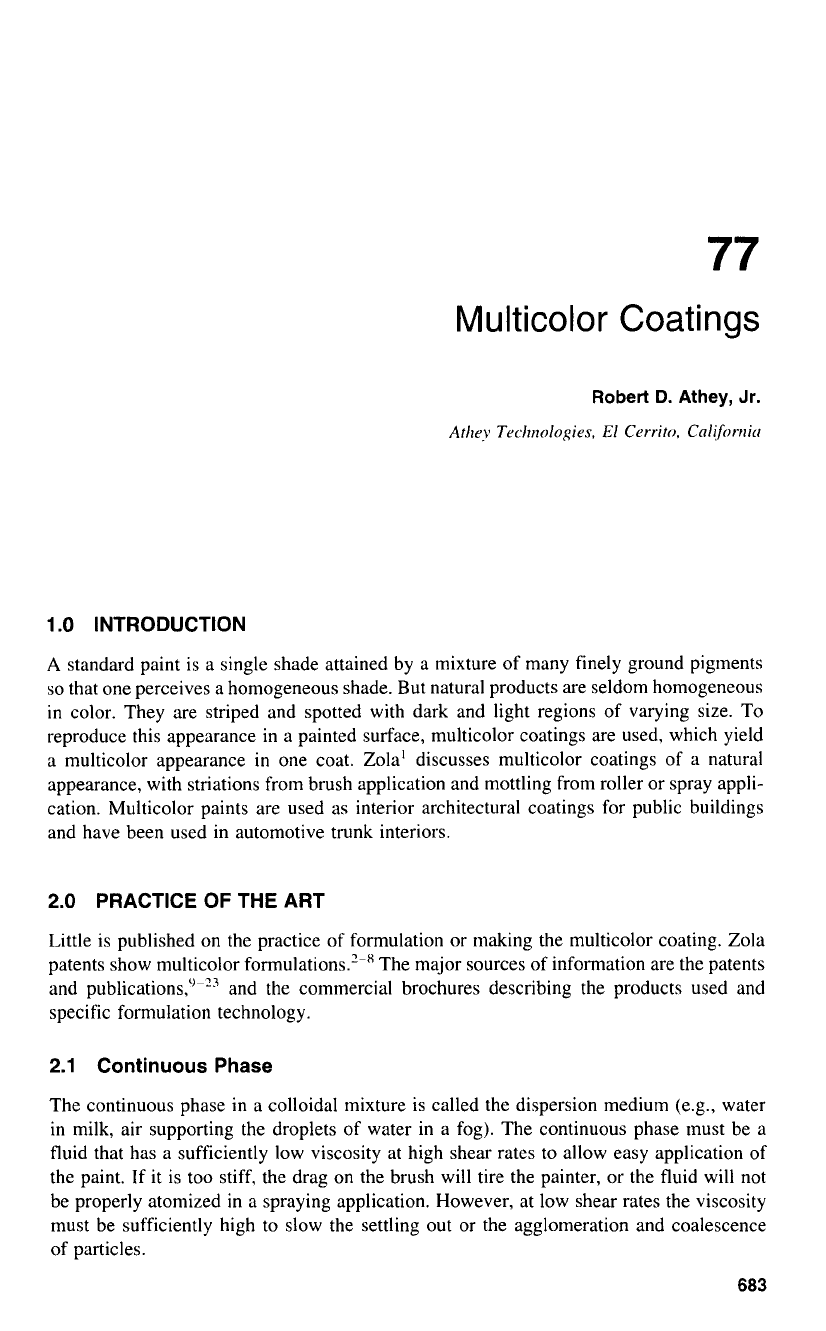
77
Multicolor
Coatings
Robert
D.
Athey,
Jr.
Athey
Technologies,
El
Cerrito. Cnljfomia
1
.O
INTRODUCTION
A
standard paint is a single shade attained by a mixture of many finely ground pigments
so
that one perceives a homogeneous shade. But natural products are seldom homogeneous
in
color. They are striped and spotted with dark and light regions of varying size.
To
reproduce this appearance in a painted surface, multicolor coatings are used, which yield
a
multicolor appearance in one coat.
Zola'
discusses multicolor coatings of
a
natural
appearance, with striations from brush application and mottling from roller
or
spray appli-
cation. Multicolor paints are used as interior architectural coatings for public buildings
and have been used in automotive trunk interiors.
2.0 PRACTICE
OF
THE ART
Little is published on the practice of formulation
or
making the multicolor coating.
Zola
patents show multicolor formulations.'-x The major sources
of
information are the patents
and publications,"-23 and the commercial brochures describing the products used and
specific formulation technology.
2.1 Continuous Phase
The continuous phase in
a
colloidal mixture is called the dispersion medium (e.g., water
in
milk, air supporting the droplets of water in a fog). The continuous phase must be
a
fluid that has a sufficiently low viscosity at high shear rates to allow easy application
of
the paint. If it is too stiff, the drag on the brush will tire the painter,
or
the fluid will not
be properly atomized
in
a
spraying application. However, at low shear rates the viscosity
must be sufficiently high to slow the settling out
or
the agglomeration and coalescence
of
particles.
683
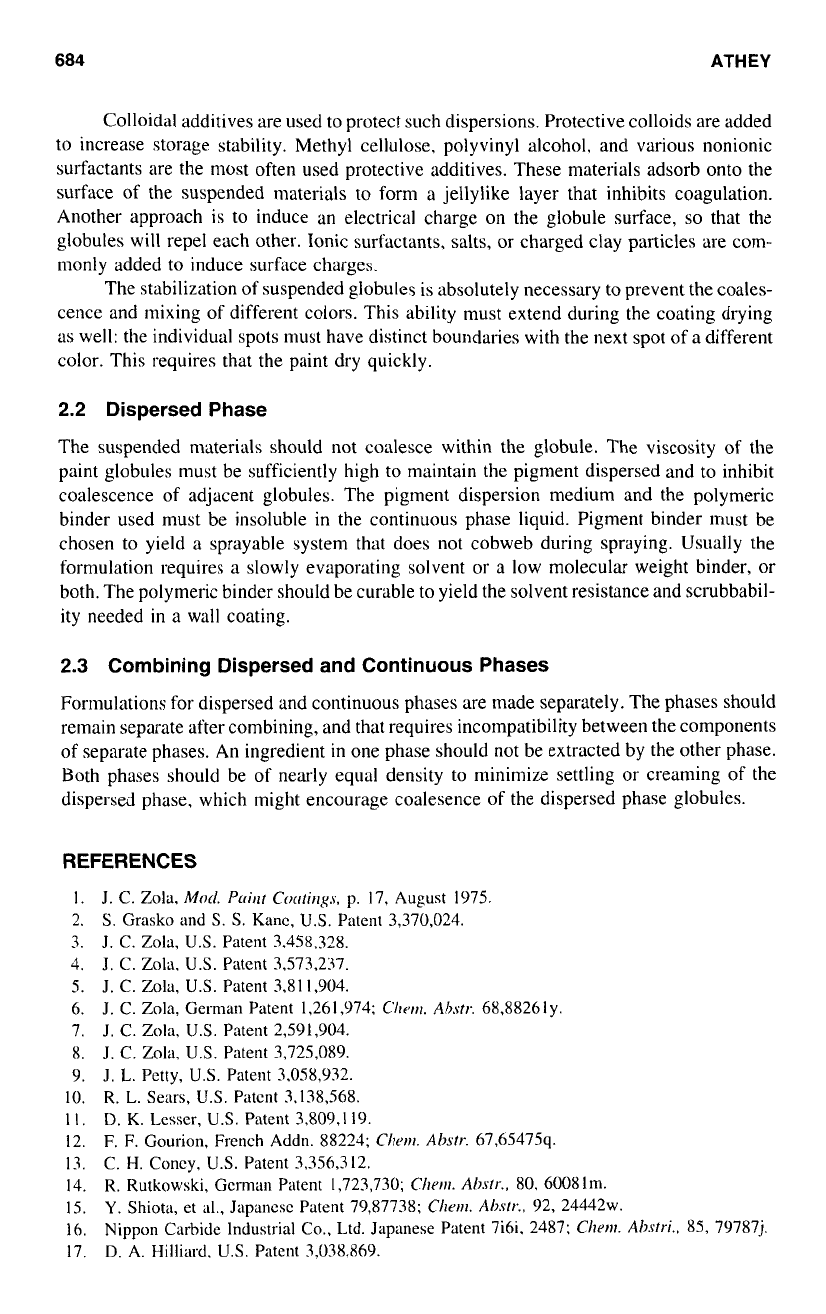
684
ATHEY
Colloidal additives are used to protect such dispersions. Protective colloids are added
to increase storage stability. Methyl cellulose, polyvinyl alcohol. and various nonionic
surfactants are the most often used protective additives. These materials adsorb onto the
surface of the suspended materials to form
a
jellylike layer that inhibits coagulation.
Another approach is to induce an electrical charge on the globule surface,
so
that the
globules will repel each other. Ionic surfactants. salts, or charged clay particles are com-
monly added
to
induce surface charges.
The stabilization
of
suspended globules is absolutely necessary to prevent the coales-
cence and mixing of different colors. This ability must extend during the coating drying
as well: the individual spots must have distinct boundaries with the next spot of a different
color. This requires that the paint dry quickly.
2.2
Dispersed Phase
The suspended materials should not coalesce within the globule. The viscosity
of
the
paint globules must be sufficiently high to maintain the pigment dispersed and to inhibit
coalescence of adjacent globules. The pigment dispersion medium and the polymeric
binder used must be insoluble in the continuous phase liquid. Pigment binder must be
chosen to yield
a
sprayable system that does not cobweb during spraying. Usually the
formulation requires a slowly evaporating solvent or
a
low molecular weight binder, or
both. The polymeric binder should be curable to yield the solvent resistance and scmbbabil-
ity
needed
in
a
wall coating.
2.3
Combining Dispersed and Continuous Phases
Formulations for dispersed and continuous phases are made separately. The phases should
remain separate after combining, and that requires incompatibility between the components
of separate phases. An ingredient
in
one phase should
not
be extracted by the other phase.
Both phases should be
of
nearly equal density to minimize settling or creaming of the
dispersed phase, which might encourage coalesence of the dispersed phase globules.
REFERENCES
1.
J. C. Zola.
Mod.
Puirlt
Cotrtirzgs.
p.
17,
August
1975.
2. S. Grasko and S.
S.
Kanc,
U.S.
Patent 3,370,024.
3.
J. C. Zola,
U.S.
Patent 3.45838.
4.
J.
C.
Zola,
U.S.
Patent 3,573,237.
5.
J.
C.
Zola,
U.S.
Patent
331
1,904.
6.
J. C. Zola, German Patent 1,261,074:
C/wrrl.
Ahstr.
68,88261~.
7. J.
C.
Zola.
US.
Patent 2,591,904.
8.
J.
C.
Zola,
U.S.
Patent 3,725,089.
9.
J.
L.
Petty,
U.S.
Patent 3,058,932.
10. R. L. Sears,
US.
Patent 3.138.568.
1
I,
D.
K.
Lesser,
US.
Patent 3,809,
I
19.
12.
F.
F.
Gourion,
French
Addn. 88224;
Chert/. Abstr.
67,65475q.
13.
C.
H. Coney,
U.S.
Patent 3,356,312.
14.
R. Rutkowski,
German
Patent 1,723,730;
Chrrrl.
Ahstr.,
80.
60081m.
15.
Y.
Shiota,
et
al.,
Japanese Patent 79,87738;
C/wm
Ahtr.,
92, 24442~.
16. Nippon Carbide Industrial
Co.,
Ltd. Japanese Patent
7i6i.
2487;
Chenl.
Ahstri.,
85,
79787j.
17.
D.
A.
Hilliard.
U.S.
Patent 3,038,869.
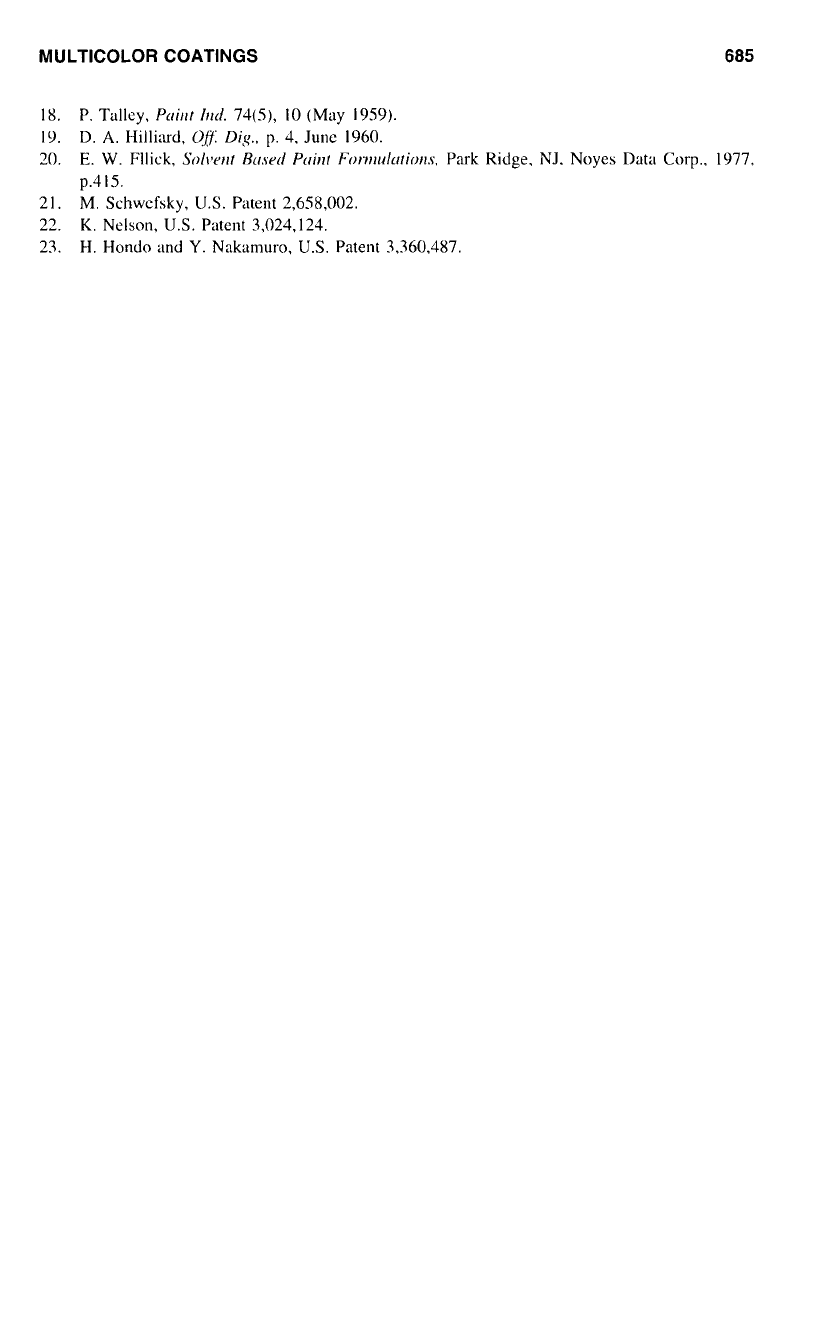
MULTICOLOR
COATINGS 685
18.
P. Talley,
Prrirrr
Id.
74(5),
10
(May 1959).
19.
D.
A.
Hi1liru.d.
Ofi:
Dig..
p.
4.
June 1960.
20.
E.
W.
Fllick,
Sohsrrt
Rtrsud
Ptrirz/
Fr,~rllu/tr/ior~.s.
Park Ridge. NJ. Noyes Data
Corp..
1977,
21.
M. Schwcfsky,
US.
Patent 2,658,002.
22.
K.
Nelson,
U.S.
Patent
3,024.1
24.
23.
H.
Hondo and
Y.
Nakarnuro,
U.S.
Patent 3,360.487.
p.4
I
5.
This Page Intentionally Left Blank
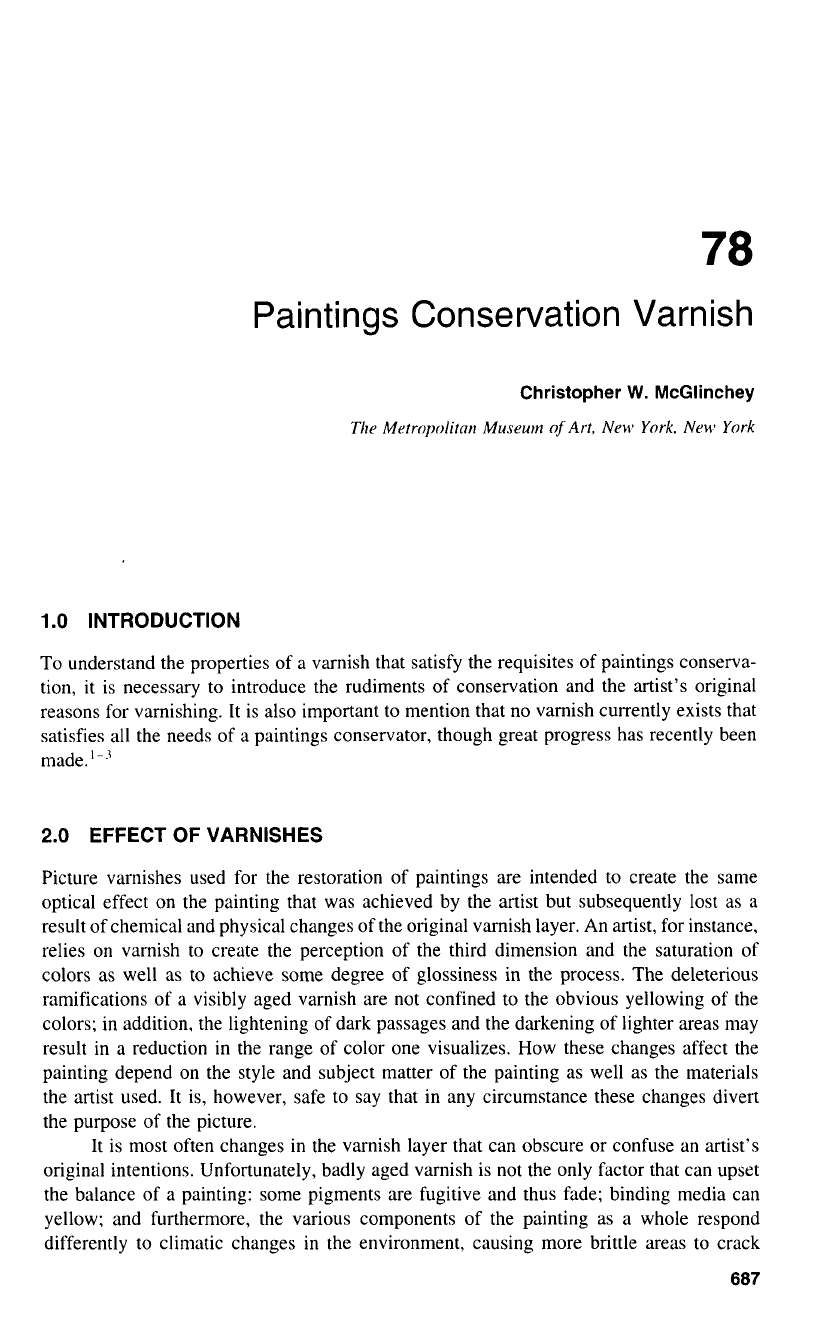
78
Paintings Conservation Varnish
Christopher
W.
McGlinchey
The
Metropolitnn
Museurn
of
Art,
New3
York,
New
York
1
.O
INTRODUCTION
To
understand the properties of a varnish that satisfy the requisites
of
paintings conserva-
tion, it is necessary
to
introduce the rudiments
of
conservation and the artist's original
reasons for varnishing. It is also important to mention that no varnish currently exists that
satisfies all the needs
of
a paintings conservator, though great progress has recently been
made.">
2.0
EFFECT OF VARNISHES
Picture varnishes used for the restoration of paintings are intended
to
create the same
optical effect on the painting that was achieved by the artist but subsequently lost as a
result
of
chemical and physical changes of the original varnish layer. An artist, for instance,
relies on varnish to create the perception
of
the third dimension and the saturation of
colors as well as
to
achieve some degree of glossiness in the process. The deleterious
ramifications of a visibly aged varnish are not confined to the obvious yellowing
of
the
colors; in addition, the lightening of dark passages and the darkening of lighter areas may
result in a reduction in the range of color one visualizes. How these changes affect the
painting depend on the style and subject matter of the painting as well as the materials
the artist used. It is, however, safe to say that in any circumstance these changes divert
the purpose
of
the picture.
It is most often changes in the varnish layer that can obscure or confuse an artist's
original intentions. Unfortunately, badly aged varnish is not the only factor that can upset
the balance of a painting: some pigments are fugitive and thus fade; binding media can
yellow: and furthermore, the various components of the painting as a whole respond
differently to climatic changes in the environment, causing more brittle areas to crack
687
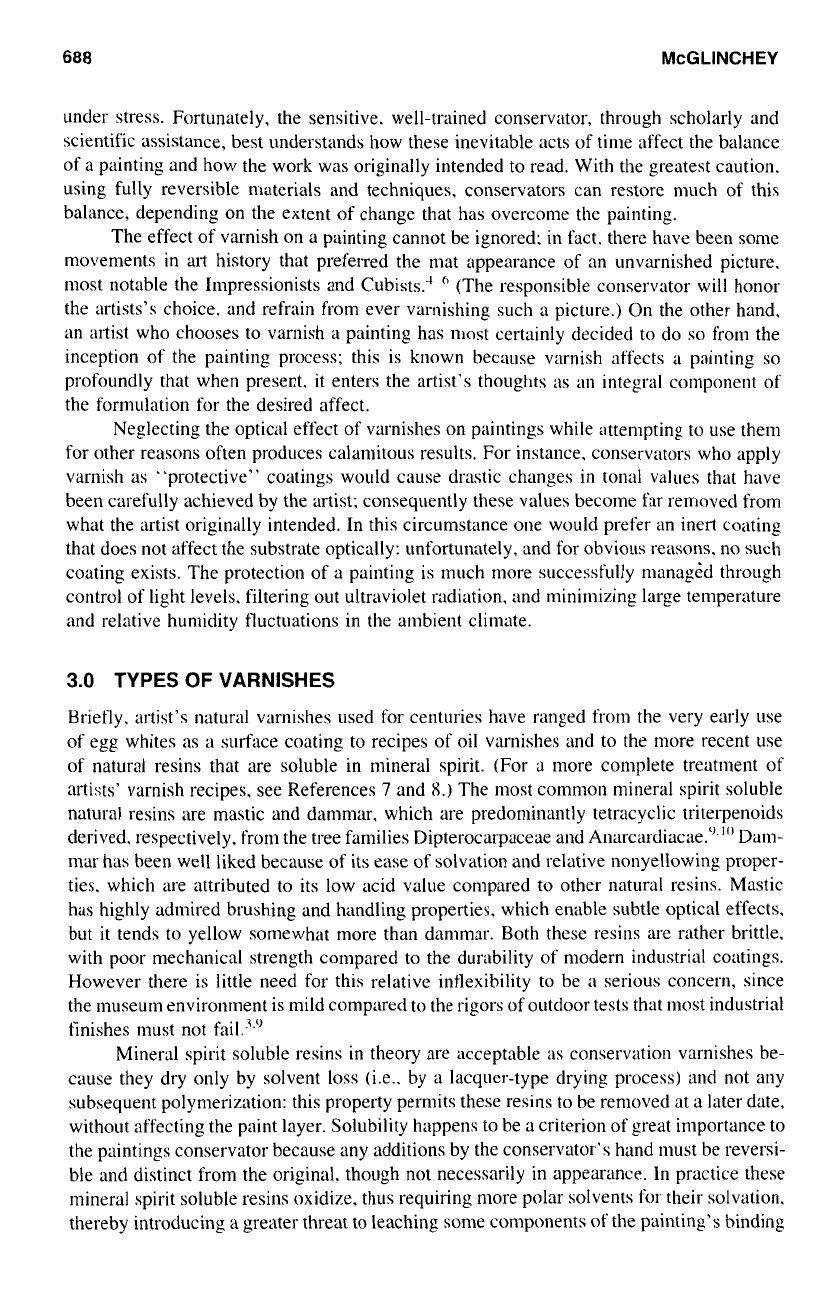
688 McGLlNCHEY
under stress. Fortunately, the sensitive. well-trained conservator, through scholarly and
scientific assistance, best understands how these inevitable acts of time affect the balance
of a painting and how the work was originally intended
to
read. With the greatest caution.
using fully reversible materials and techniques, conservators can restore much of this
balance, depending
on
the extent
of
change that has overcome the painting.
The effect of varnish on a painting cannot be ignored: in fact. there have been some
movements in art history that preferred the mat appearance of an unvarnished picture.
most notable the Inlpressionists and Cubists.4
''
(The responsible conservator will honor
the artists's choice. and refrain from ever varnishing such
a
picture.)
On
the other hand.
an artist who chooses
to
varnish
a
painting has most certainly decided to do
so
from the
inception of the painting process; this is known because varnish affects
a
painting
so
profoundly that when present.
it
enters the artist's thoughts
as
an integral component of
the formulation for the desired affect.
Neglecting the optical effect of varnishes on paintings while attempting to use them
for other reasons often produces calamitous results. For instance, conservators who apply
varnish as "protective" coatings would cause drastic changes
in
tonal values that have
been carefully achieved by the artist; consequently these values become far removed from
what the artist originally intended. In this circumstance one would prefer an inert coating
that does not affect the substrate optically: unfortunately, and for obvious reasons. no such
coating exists. The protection of a painting is much more successfully managed through
control of light levels, filtering out ultraviolet radiation. and minimizing large temperature
and relative humidity fluctuations in the ambient climate.
3.0
TYPES
OF
VARNISHES
Briefly. artist's natural varnishes used for centuries have ranged from the very early use
of
egg whites as a surface coating to recipes of
oil
varnishes and
to
the more recent use
of natural resins that are soluble
in
mineral spirit. (For
a
more complete treatment of
artists' varnish recipes, see References
7
and
8.)
The most common mineral spirit soluble
natural resins are mastic and dammar, which are predominantly tetracyclic triterpenoids
derived. respectively, from the tree families Dipterocarpaceae and Anarcardiacae.".'" Dam-
mar has been well liked because
of
its ease of solvation and relative nonyellowing proper-
ties. which are attributed to its low acid value conlpared
to
other natural resins. Mastic
has highly admired brushing and handling properties, which enable subtle optical effects.
but
it
tends to yellow somewhat more than dammar. Both these resins are rather brittle.
with poor mechanical strength compared to the durability of modern industrial coatings.
However there is little need for this relative inflexibility to be
;I
serious concern, since
the museum environment
is
mild compared to the rigors
of
outdoor tests that most industrial
finishes must not fail.',"
Mineral spirit soluble resins
in
theory are acceptable
as
conservation varnishes be-
cause they dry
only
by solvent
loss
(i.e., by
a
lacquer-type drying process) and not ally
subsequent polymerization: this property permits these resins to be removed at a later date,
without affecting the paint layer. Solubility happens to be a criterion
of
great importance to
the paintings conservator because any additions by the conservator's hand must be reversi-
ble and distinct from the original. though not necessarily in appearance. In practice these
mineral spirit soluble resins oxidize. thus requiring more polar solvents for their solvation.
thereby introducing a greater threat to leaching some components
of
the painting's binding
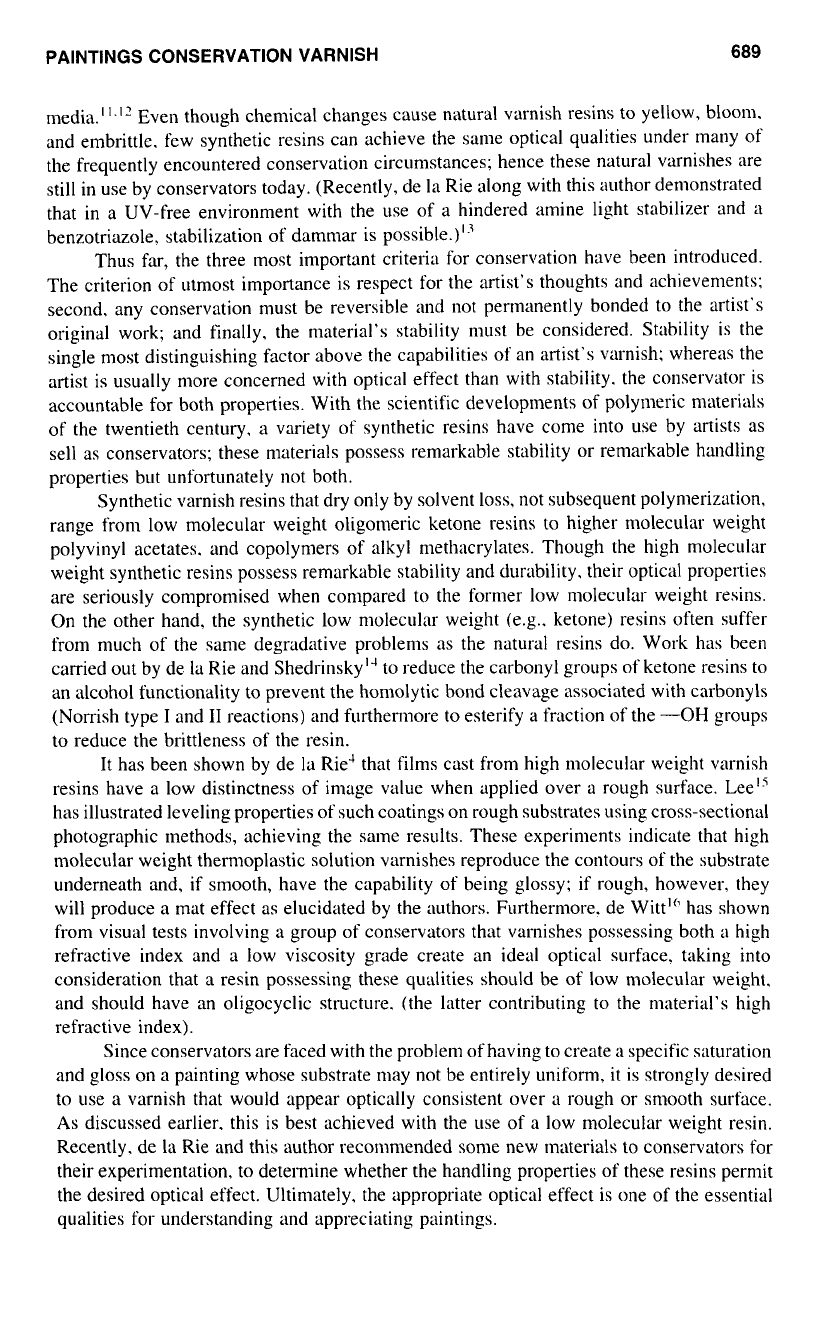
PAINTINGS CONSERVATION VARNISH
689
media."." Even though chemical changes cause natural varnish resins to yellow, bloom.
and embrittle. few synthetic resins can achieve the same optical qualities under Inany
of
the frequently encountered conservation circumstances; hence these natural varnishes are
still in use by conservators today. (Recently, de la Rie along with this author demonstrated
that in
a
UV-free environment with the use of a hindered amine light stabilizer and
a
benzotriazole. stabilization
of
dammar is possible.)I3
Thus far, the three most important criteria for conservation have been introduced.
The criterion of utmost importance is respect for the artist's thoughts and achievements;
second, any conservation must be reversible and
not
permanently bonded to the artist's
original work; and f'inally, the material's stability must be considered. Stability is the
single
most
distinguishing factor above the capabilities
of
an artist's varnish; whereas the
artist is usually more concerned with optical effect than with stability. the conservator is
accountable for both properties. With the scientific developments
of
polymeric materials
of the twentieth century.
a
variety of synthetic resins have come into use by artists as
sell as conservators; these materials possess remarkable stability or remarkable handling
properties but unfortunately not both.
Synthetic varnish resins that dry only by solvent
loss,
not subsequent polymerization,
range from low molecular weight oligomeric ketone resins
to
higher molecular weight
polyvinyl acetates. and copolymers
of
alkyl methacrylates. Though the high molecular
weight synthetic resins possess remarkable stability and durability. their optical properties
are seriously compromised when compared to the former low molecular weight resins.
On the other hand, the synthetic low molecular weight (e.g.. ketone) resins often suffer
from much of the same degradative problems as the natural resins do. Work has been
carried out by de la Rie and Shedrinsky" to reduce the carbonyl groups of ketone resins to
an alcohol functionality to prevent the homolytic bond cleavage associated with carbonyls
(Norrish type
I
and
I1
reactions) and furthermore
to
esterify a fraction of the
"OH
groups
to reduce the brittleness of the resin.
It
has been shown by de la Rie' that films cast from high molecular weight varnish
resins have a low distinctness of image value when applied over a rough surface. Lee"
has illustrated leveling properties of such coatings on rough substrates using cross-sectional
photographic methods, achieving the same results. These experiments indicate that high
molecular weight thermoplastic solution varnishes reproduce the contours of the substrate
underneath and,
if
smooth, have the capability
of
being glossy; if rough, however, they
will produce a mat effect as elucidated by the authors. Furthermore. de Witt'" has shown
from visual tests involving
a
group of conservators that varnishes possessing both
;I
high
refractive index and
a
low viscosity grade create an ideal optical surface. taking into
consideration that a resin possessing these qualities should be
of
low molecular weight,
and should have an oligocyclic structure. (the latter contributing
to
the material's high
refractive index).
Since conservators are faced with the problem of having
to
create
a
specific saturation
and
gloss
on
a painting whose substrate may not be entirely uniform,
it
is strongly desired
to
use a varnish that would appear optically consistent over
a
rough or smooth surface.
As
discussed earlier, this is best achieved with the use of a low molecular weight resin.
Recently, de la Rie and this author recommended some new materials to conservators for
their experimentation, to determine whether the handling properties of these resins permit
the desired optical effect. Ultimately, the appropriate optical effect is one of the essential
qualities for understanding and appreciating paintings.
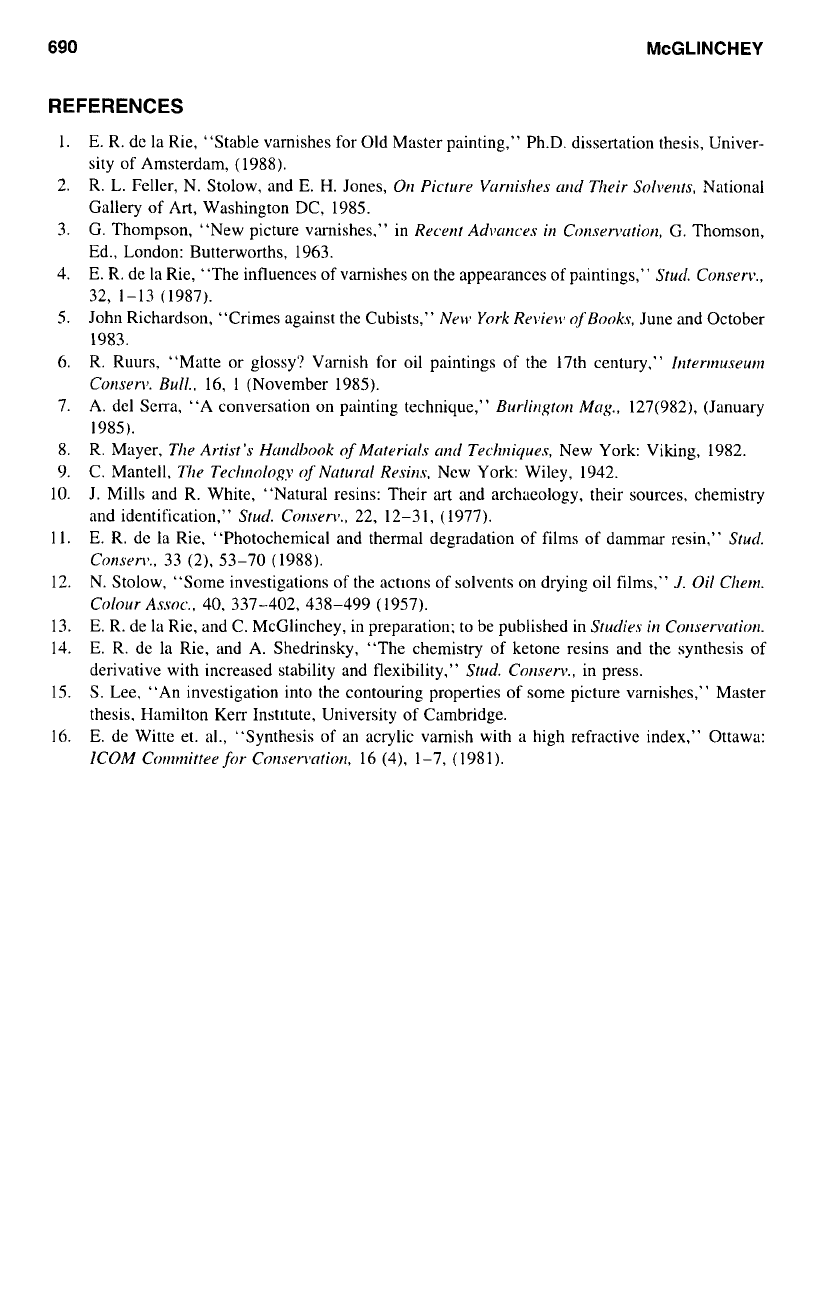
690
REFERENCES
McGLlNCHEY
I.
2.
3.
4.
S.
6.
7.
8.
9.
10.
1
I.
12.
13.
14.
IS.
16.
E.
R. de la Rie, “Stable varnishes for Old Master painting,” Ph.D. dissertation thesis, Univer-
sity of Amsterdam,
(1988).
R. L. Feller, N. Stolow, and
E.
H.
Jones,
011
Picture
Vwnishes
cr~d
Their
Sol~errts,
National
Gallery of Art, Washington DC,
1985.
G. Thompson, “New picture varnishes,” in
Recent
Adwnces
~II
Corl.srr\wtiorl,
G.
Thomson,
Ed., London: Butterworths,
1963.
E.
R. de la Rie, “The influences of varnishes on the appearances of paintings,”
Stud
cons en^.,
John Richardson, “Crimes against the Cubists,”
New
York
Review
qf’Books,
June and October
1983.
R. Ruurs, “Matte or glossy’? Varnish for oil paintings of the 17th century,’’
Oltennuseurn
Corlsenj.
Bull..
16,
1
(November
1985).
A. del Serra. “A conversation on painting technique,”
Burlirlgtorl
Mug.,
127(982),
(January
1985).
R. Mayer,
The
Artist’s
Hmdlmok
of
Mrrtrrirrls
and
Techiques,
New York: Viking,
1982.
C.
Mantell,
The
Technology
of
Nrrturtrl
Resir1.s.
New York: Wiley,
1942.
J.
Mills and R. White, “Natural resins: Their art and archaeology, their sources, chemistry
and identification,”
Stud.
Corlserv.,
22, 12-3
I,
(1977).
E.
R. de la Rie. “Photochemical and thermal degradation of films of dammar resin,”
Stud.
Corwrv..
33 (2). 53-70 (1988).
N. Stolow, “Some investigations of the actlons
of
solvents on drying oil films,”
J.
Oil
Cllern.
Colour
Assoc.,
40. 337-402, 438-499 (1957).
E.
R. de
la
Rie, and C. McGlinchey, in preparation: to be published in
Studies
ir~
Corlsenwtiorl.
E.
R. de la Rie, and A. Shedrinsky, “The chemistry
of
ketone resins and the synthesis of
derivative with increased stability and flexibility.”
Stud.
Corrserv.,
in press.
S.
Lee, “An investigation into the contouring properties of some picture varnishes,” Master
thesis. Hamilton Kerr Instltute, University of Cambridge.
E. de Witte et. al., “Synthesis of an acrylic varnish with
a
high refractive index,” Ottawa:
ICOM
Cormnitfee
f.r Corl.servntiorl,
16
(4),
1-7,
(I
981).
32,
1-13
(1987).
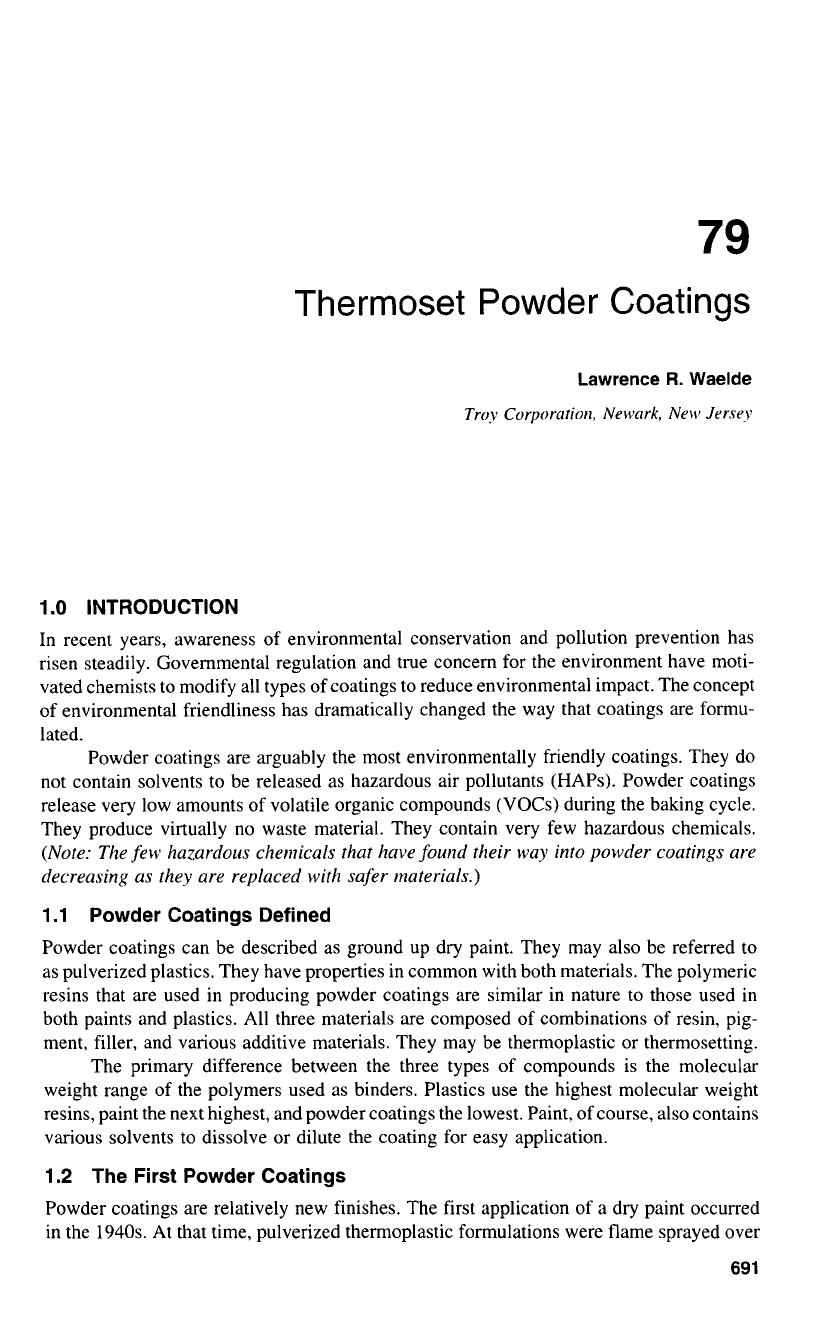
79
Thermoset Powder Coatings
Lawrence
R.
Waelde
Troy Corporation,
Newark,
New
Jersry
1
.O
INTRODUCTION
In recent years, awareness
of
environmental conservation and pollution prevention has
risen steadily. Governmental regulation and true concern for the environment have moti-
vated chemists to modify all types of coatings to reduce environmental impact. The concept
of environmental friendliness has dramatically changed the way that coatings are formu-
lated.
Powder coatings are arguably the most environmentally friendly coatings. They do
not contain solvents
to
be released as hazardous air pollutants (HAPS). Powder coatings
release very low amounts
of
volatile organic compounds
(VOCs)
during the baking cycle.
They produce virtually no waste material. They contain very few hazardous chemicals.
(Note: The few hazardous chemicals that have found their way into powder coatings are
decreasing as they are replaced with safer materials.)
1.1 Powder Coatings Defined
Powder coatings can be described
as
ground up dry paint. They may also be referred to
as
pulverized plastics. They have properties in common with both materials. The polymeric
resins that are used in producing powder coatings are similar in nature to those used in
both paints and plastics. All three materials are composed of combinations of resin, pig-
ment, filler, and various additive materials. They may be thermoplastic or thermosetting.
The primary difference between the three types of compounds is the molecular
weight range of the polymers used
as
binders. Plastics use the highest molecular weight
resins, paint the next highest, and powder coatings the lowest. Paint, of course, also contains
various solvents to dissolve or dilute the coating for easy application.
1.2 The First Powder Coatings
Powder coatings are relatively new finishes. The first application of
a
dry paint occurred
in the 1940s. At that time, pulverized thermoplastic formulations were flame sprayed over
691
